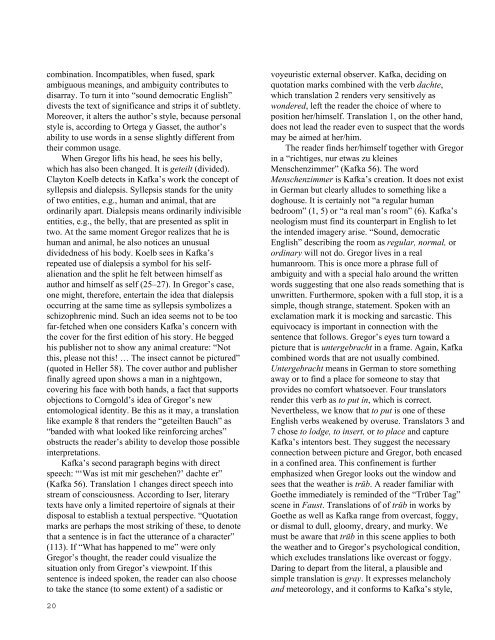their - The University of Texas at Dallas
their - The University of Texas at Dallas
their - The University of Texas at Dallas
Create successful ePaper yourself
Turn your PDF publications into a flip-book with our unique Google optimized e-Paper software.
combin<strong>at</strong>ion. Incomp<strong>at</strong>ibles, when fused, spark<br />
ambiguous meanings, and ambiguity contributes to<br />
disarray. To turn it into “sound democr<strong>at</strong>ic English”<br />
divests the text <strong>of</strong> significance and strips it <strong>of</strong> subtlety.<br />
Moreover, it alters the author’s style, because personal<br />
style is, according to Ortega y Gasset, the author’s<br />
ability to use words in a sense slightly different from<br />
<strong>their</strong> common usage.<br />
When Gregor lifts his head, he sees his belly,<br />
which has also been changed. It is geteilt (divided).<br />
Clayton Koelb detects in Kafka’s work the concept <strong>of</strong><br />
syllepsis and dialepsis. Syllepsis stands for the unity<br />
<strong>of</strong> two entities, e.g., human and animal, th<strong>at</strong> are<br />
ordinarily apart. Dialepsis means ordinarily indivisible<br />
entities, e.g., the belly, th<strong>at</strong> are presented as split in<br />
two. At the same moment Gregor realizes th<strong>at</strong> he is<br />
human and animal, he also notices an unusual<br />
dividedness <strong>of</strong> his body. Koelb sees in Kafka’s<br />
repe<strong>at</strong>ed use <strong>of</strong> dialepsis a symbol for his selfalien<strong>at</strong>ion<br />
and the split he felt between himself as<br />
author and himself as self (25–27). In Gregor’s case,<br />
one might, therefore, entertain the idea th<strong>at</strong> dialepsis<br />
occurring <strong>at</strong> the same time as syllepsis symbolizes a<br />
schizophrenic mind. Such an idea seems not to be too<br />
far-fetched when one considers Kafka’s concern with<br />
the cover for the first edition <strong>of</strong> his story. He begged<br />
his publisher not to show any animal cre<strong>at</strong>ure: “Not<br />
this, please not this! … <strong>The</strong> insect cannot be pictured”<br />
(quoted in Heller 58). <strong>The</strong> cover author and publisher<br />
finally agreed upon shows a man in a nightgown,<br />
covering his face with both hands, a fact th<strong>at</strong> supports<br />
objections to Corngold’s idea <strong>of</strong> Gregor’s new<br />
entomological identity. Be this as it may, a transl<strong>at</strong>ion<br />
like example 8 th<strong>at</strong> renders the “geteilten Bauch” as<br />
“banded with wh<strong>at</strong> looked like reinforcing arches”<br />
obstructs the reader’s ability to develop those possible<br />
interpret<strong>at</strong>ions.<br />
Kafka’s second paragraph begins with direct<br />
speech: “‘Was ist mit mir geschehen’ dachte er”<br />
(Kafka 56). Transl<strong>at</strong>ion 1 changes direct speech into<br />
stream <strong>of</strong> consciousness. According to Iser, literary<br />
texts have only a limited repertoire <strong>of</strong> signals <strong>at</strong> <strong>their</strong><br />
disposal to establish a textual perspective. “Quot<strong>at</strong>ion<br />
marks are perhaps the most striking <strong>of</strong> these, to denote<br />
th<strong>at</strong> a sentence is in fact the utterance <strong>of</strong> a character”<br />
(113). If “Wh<strong>at</strong> has happened to me” were only<br />
Gregor’s thought, the reader could visualize the<br />
situ<strong>at</strong>ion only from Gregor’s viewpoint. If this<br />
sentence is indeed spoken, the reader can also choose<br />
to take the stance (to some extent) <strong>of</strong> a sadistic or<br />
voyeuristic external observer. Kafka, deciding on<br />
quot<strong>at</strong>ion marks combined with the verb dachte,<br />
which transl<strong>at</strong>ion 2 renders very sensitively as<br />
wondered, left the reader the choice <strong>of</strong> where to<br />
position her/himself. Transl<strong>at</strong>ion 1, on the other hand,<br />
does not lead the reader even to suspect th<strong>at</strong> the words<br />
may be aimed <strong>at</strong> her/him.<br />
<strong>The</strong> reader finds her/himself together with Gregor<br />
in a “richtiges, nur etwas zu kleines<br />
Menschenzimmer” (Kafka 56). <strong>The</strong> word<br />
Menschenzimmer is Kafka’s cre<strong>at</strong>ion. It does not exist<br />
in German but clearly alludes to something like a<br />
doghouse. It is certainly not “a regular human<br />
bedroom” (1, 5) or “a real man’s room” (6). Kafka’s<br />
neologism must find its counterpart in English to let<br />
the intended imagery arise. “Sound, democr<strong>at</strong>ic<br />
English” describing the room as regular, normal, or<br />
ordinary will not do. Gregor lives in a real<br />
humanroom. This is once more a phrase full <strong>of</strong><br />
ambiguity and with a special halo around the written<br />
words suggesting th<strong>at</strong> one also reads something th<strong>at</strong> is<br />
unwritten. Furthermore, spoken with a full stop, it is a<br />
simple, though strange, st<strong>at</strong>ement. Spoken with an<br />
exclam<strong>at</strong>ion mark it is mocking and sarcastic. This<br />
equivocacy is important in connection with the<br />
sentence th<strong>at</strong> follows. Gregor’s eyes turn toward a<br />
picture th<strong>at</strong> is untergebracht in a frame. Again, Kafka<br />
combined words th<strong>at</strong> are not usually combined.<br />
Untergebracht means in German to store something<br />
away or to find a place for someone to stay th<strong>at</strong><br />
provides no comfort wh<strong>at</strong>soever. Four transl<strong>at</strong>ors<br />
render this verb as to put in, which is correct.<br />
Nevertheless, we know th<strong>at</strong> to put is one <strong>of</strong> these<br />
English verbs weakened by overuse. Transl<strong>at</strong>ors 3 and<br />
7 chose to lodge, to insert, or to place and capture<br />
Kafka’s intentors best. <strong>The</strong>y suggest the necessary<br />
connection between picture and Gregor, both encased<br />
in a confined area. This confinement is further<br />
emphasized when Gregor looks out the window and<br />
sees th<strong>at</strong> the we<strong>at</strong>her is trüb. A reader familiar with<br />
Goethe immedi<strong>at</strong>ely is reminded <strong>of</strong> the “Trüber Tag”<br />
scene in Faust. Transl<strong>at</strong>ions <strong>of</strong> <strong>of</strong> trüb in works by<br />
Goethe as well as Kafka range from overcast, foggy,<br />
or dismal to dull, gloomy, dreary, and murky. We<br />
must be aware th<strong>at</strong> trüb in this scene applies to both<br />
the we<strong>at</strong>her and to Gregor’s psychological condition,<br />
which excludes transl<strong>at</strong>ions like overcast or foggy.<br />
Daring to depart from the literal, a plausible and<br />
simple transl<strong>at</strong>ion is gray. It expresses melancholy<br />
and meteorology, and it conforms to Kafka’s style,<br />
20

















